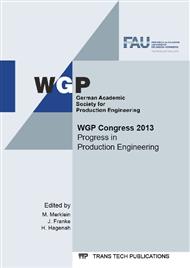p.3
p.11
p.19
p.27
p.34
p.42
p.53
p.61
An Integrated Simulation Approach to the Development of Assembly System Components
Abstract:
Commonly, a modelling and simulation approach is used for parameter optimization and system behavior analysis of assembly system components. However, such simulation approaches are often not well integrated or its analysis is still based on a specific physical domain. This paper proposes an integrated simulation approach that can be used for designing, analyzing and optimizing the entire physical domain as well as the control system of mechatronic components in an assembly system. The state-of-the-art, requirements, our concept and the limitations of an integrated simulation approach are explained in this paper. A case study of the development of conveyor systems using the multi-domain simulation tool OpenModelica is also presented. On-going research shows that the integrated approach offers various benefits such as reduced development time and minimized errors, as well as maintenance during the commissioning process.
Info:
Periodical:
Pages:
19-26
Citation:
Online since:
September 2013
Keywords:
Price:
Сopyright:
© 2013 Trans Tech Publications Ltd. All Rights Reserved
Share:
Citation:


